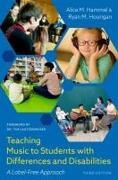Read more
The latest edition of the landmark text
Teaching Music to Students with Differences and Disabilities: A Label-Free Approach--designed for music education faculty, in-service music administrators, in-service music teachers, and preservice music teachers--offers a comprehensive manual and reference guide that introduces those in the field of music education to best practices when teaching music to students with differences and disabilities. Acclaimed pedagogues and clinicians Alice Hammel and Ryan Hourigan addresses a variety of topics such as research-based strategies for methods courses, practical approaches for in-service music educators, and professional development grounded in research, special education law, and best practice.
List of contents
- THE CURRENT LANDSCAPE OF THE SPECIAL EDUCATION SYSTEM IN THE UNITED STATES
- Public School Education within a Democracy
- Chapter 2: The Current Structure of Special Education in Our Schools
- PREPARING TO TEACH MUSIC TO STUDENTS WITH SPECIAL NEEDS
- Chapter 3: Preparing to Teach: Practicum and Engagement Opportunities in Special Education for Preservice and In-Service Music Educators
- Chapter 4: A Resourceful and Pedagogical Approach to Teaching Students with Differences and Disabilities
- PRACTICAL CLASSROOM ADAPTATIONS, MODIFICATIONS, AND ASSESSMENT TECHNIQUES FOR TEACHING STUDENTS WITH SPECIAL NEEDS IN THE MUSIC CLASSROOM
- Chapter 5: Developing a Student-Centered and Inclusive Music Classroom
- Chapter 6: Curriculum and Assessment for Students with Differences and Disabilities
- Chapter 7: Teaching Strategies for Performers with Differences and Disabilities
- Chapter 8: Teaching Music to Students Who Are Intellectually Gifted
- RESOURCES FOR MUSIC EDUCATORS
- Chapter 9: Resources for Music Teachers and Music Teacher Educators Regarding Teaching Students with Special Needs
About the author
Alice M. Hammel, Virginia (USA) Outstanding Music Educator of the Year (2018) and current President of the Virginia Music Educators Association (USA), is a widely known music educator, author, and clinician whose experience in music is extraordinarily diverse. She a member of the faculty of University of Arkansas and has many years of experience teaching instrumental and choral music in public and private schools. She also teaches online courses through many institutions throughout the United States. She has maintained a large, independent flute studio for over 35 years.
Ryan M. Hourigan (2010 Indiana Music Educators Association Outstanding University Music Educator of the Year, 2021 University of Michigan Kendall Award winner) joined the faculty at Ball State University in the fall of 2006 after nine years of teaching music at the secondary and university level in Illinois. Dr. Hourigan holds degrees from Eastern Illinois University (B.M.), Michigan State University (M.M. Wind
Conducting) and a Ph.D. in Music Education from The University of Michigan. Dr. Hourigan currently is professor of music education and is the former Director of the School of Music at Ball State University.
Summary
The latest edition of the landmark text Teaching Music to Students with Differences and Disabilities: A Label-Free Approach--designed for music education faculty, in-service music administrators, in-service music teachers, and preservice music teachers--offers a comprehensive manual and reference guide that introduces those in the field of music education to best practices when teaching music to students with differences and disabilities. Acclaimed pedagogues and clinicians Alice Hammel and Ryan Hourigan addresses a variety of topics such as research-based strategies for methods courses, practical approaches for in-service music educators, and professional development grounded in research, special education law, and best practice. Like previous editions, a core focus this book is that a student with differences and disabilities is an individual who deserves a music education that is free of labels. This philosophical premise of a label-free approach is centered in the preservation of the individual personhood of each student. Through this approach, music educators will be able to gain and advocate for support, understand their rights and responsibilities, and offer an affective and effective music education for students with and without disabilities. This includes learning strategies for effective collaboration with special educators, teacher educators, and classroom teachers. The authors also include curriculum development ideas, lesson plan strategies, observation strategies (methods classroom), and practical ideas (methods classroom).
Additional text
Clear, concise, and accessible to music educators...The authors have done an excellent job of presenting their information...The book has a multitude of strengths, and I would highly recommend it for music ecucators at any stage of their careers.

